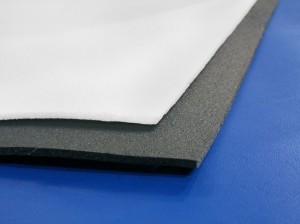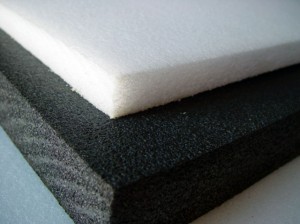At Foam Factory, Inc., we offer a broad range of foam cutting services, ranging from computer-controlled machines, to hand-crafted cuts made by team members with decades of experience. However, not every project brought to us requires the precision of sophisticated machinery or craftsman-level skill. For simple jobs and projects, DIY cutting is not only the most affordable choice, it’s quicker and easier as well. In this post, we’ll give you the run-down on how to cut closed-cell foam at home and get factory-quality results.
Closed-cell foam is a unique material, with a cellular structure that causes many of its varieties to behave like fabric in thin sheets, or rubber slabs in thicker sections. Because of this, there are multiple cutting techniques that are more effective for certain foam types and the thickness of the material being worked with.
Getting Started
Before going right to the different types of cutting methods, it’s important to address the materials you will need. Unlike open-cell foam, closed-cell foams should be cut with a straight blade like a utility knife or a crafting knife. These straight blades work well because they often feature disposable blades that make it easy to keep the knife sharp and cutting smoothly. Scissors may also be used on some informal projects, though their use should be restricted to certain foam types and thicknesses. It’s always a good idea to have a guiding straight-edge on-hand as well. Lastly, always work on a flat, stable surface that won’t be damaged by any work you do.
Neoprene, Cross-Linked Polyethylene, Gym Rubber, and Polyethylene Roll

Neoprene is a rubbery foam, cross-linked polyethylene (XLPE) is similar but slightly more plastic-like, polyethylene roll is a thin, flexible material very similar to XLPE, and gym rubber is spongy, with the ability to be the softest or firmest material among these four types, depending on formulation. Despite these physical differences, the structures of these foam types remain similar enough to take the same general approach when it comes to cutting at home.
Using Scissors
When dealing with neoprene, gym rubber, XLPE, or polyethylene roll, the first thing to consider is the thickness of the foam. If your project has you working with sheets of foam measuring 1/8” or less, you may have the option of cutting with sharp scissors. Scissors are only suggested for small, recreational projects like crafts or card making because they can leave uneven edges. If you’re making something like shapes for bath toys, or trimming tiny sections for backing in cards, scissors are a quick, effective method. PE roll is the easiest material of these four types to cut using scissors because of its fabric-like flexibility.
Single-Pass Cutting Method
For projects that involve materials thicker than 1/8” and demand precision, you will want to use a straight-bladed knife. Thickness is a consideration again, this time with it dictating how you should cut with your straight blade.
If you’re cutting one of these foam varieties 1/2″ or less in thickness, you should use the single-pass method, where you cut completely through the foam, in a single, long stroke. Using the single-pass method ensures the cleanest edges, as the blade is only passing through the foam once. However, on materials more than 1/2″ thick, it is difficult to keep the blade moving smoothly through the material, which will leave you with a sloppy edge.
To complete single-pass cuts, first be sure the foam is anchored where you will start the cut to keep the sheet from puckering under pressure. The best way to avoid this is placing a straight edge along your cutting line and applying pressure at the head of the cut as you work. Whenever possible, enter the foam from an outside edge and do not stop cutting once you’ve begun for the cleanest edges.
Multiple-Pass Cutting Method

For closed-cell foam thicker than 1/2″, drawing a knife through the material in a single pass is difficult to do without snags. When attempted, excessive force is applied rather than letting the knife’s sharpness slice through the material, and you get less-than-ideal cuts.
To cut a thick sheet of foam, the multiple-pass cutting method works well. Using a straight-edge that runs the full length of your cut is the most important step in this cutting strategy, as you will need to follow the same cut multiple times and don’t want the material to shift.
Once your cutting line is established and your straight-edge in place, begin your cut the same way you did with the single-pass method. But instead of plunging the blade completely through the foam, only cut a slice about 1/8″ to 1/4″ of the way through the foam; just enough depth to keep the blade moving without having to force it. It is also very important that you make your shallow cuts the entire length of the foam. After each pass through, start at the beginning and slice more deeply along your straight edge until you’ve made it all the way through the foam sheet, and you’ll be set!
Polyethylene:
One of the most common closed-cell foams, polyethylene has numerous densities which affect cell size, firmness, and flexibility. In its lowest densities, it has a fairly large and bubbly cell structure, which can impact how clean a cutting edge is. Because of this, we suggest against using scissors to cut polyethylene. Follow the same steps for single-pass cutting on sheets thicker than 1/2″ and the multi-cut method for thicker pieces, and you should have no problems trimming down your polyethylene foam.
NOTE: These cutting instructions do not include expanded polystyrene (EPS), which is most efficiently cut with special hot wire cutters.


I have some multi-layer stuff foam that came on a large item. I wish to cut it and reuse it. I may need to reflux it so it’s the correct shape. I need more instructions.
Please Contact Us for more information regarding your application.